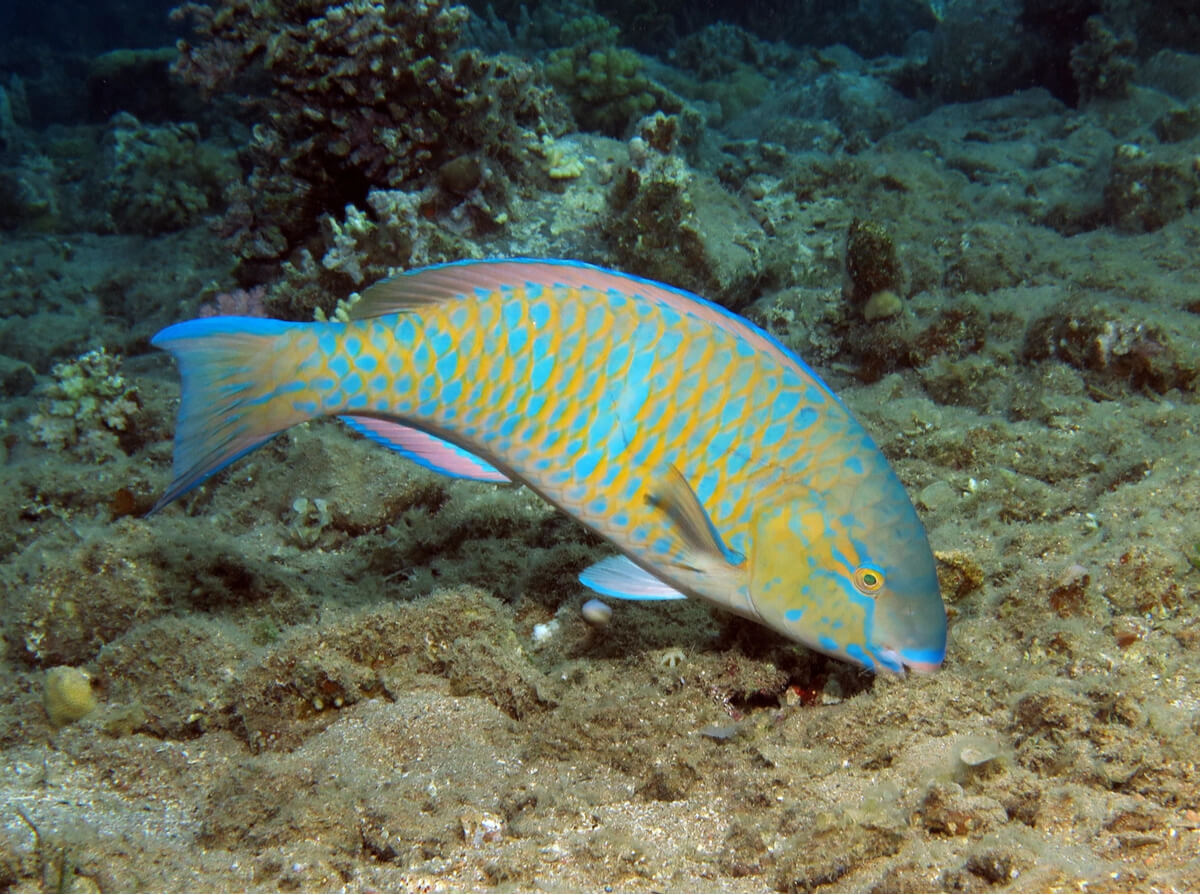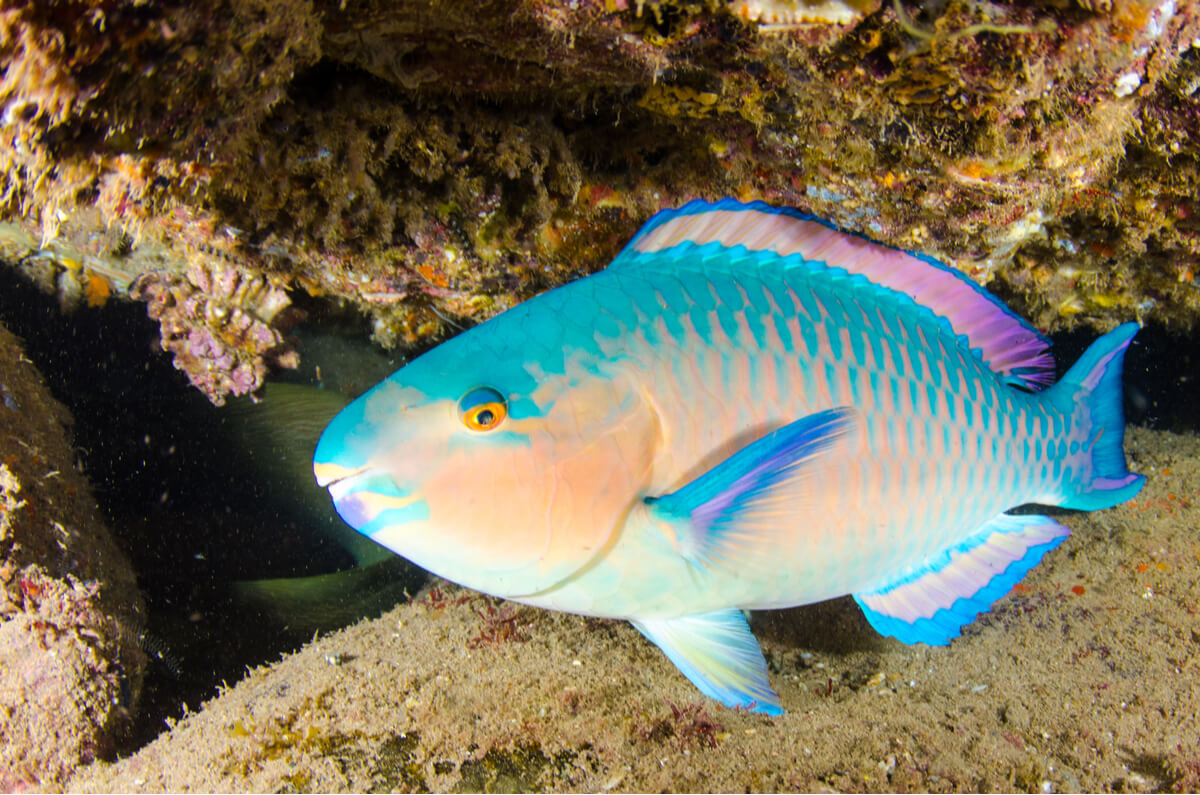7 Curiosities of the Parrotfish


Written and verified by the biologist Samuel Sanchez
The oceans are as vast as they are mysterious. As of today, an exact figure that reflects the biodiversity of aquatic ecosystems cannot be provided, but according to professional sources, it’s believed that there are more than 33,600 species of fish around the world. One of the most fascinating and curious is the parrotfish.
This marine actinopterygian fish stands out for its size, colors and habits, as experts believe it actively participates in the bioerosion of aquatic ecosystems and performs irreplaceable functions. If you want to know more about the parrotfish and its relatives, keep reading and discover 7 curiosities about them.
1. The term “parrotfish” encompasses many species
If we refer to a “parrotfish” in a general way, we’re actually talking about 95 species with common characteristics, belonging to the Scaridae family.
Perhaps the most common one within this taxon is the common parrotfish (Scarus psittacus), as it belongs to the genus Scarus, which includes 52 of the parrotfish species distributed throughout the different oceans of the world. In any case, there are many related animals that can be called “parrotfish”, due to their common characteristics and habits.
The variety of parrotfish is divided into 9 genera, all part of the Scaridae family.
2. A group of tropical species
One of the best-known characteristics of the parrotfish is that it’s an eminently tropical animal. Regardless of the species we look at, they’re all found primarily in the warm waters of the Atlantic, Indian, and Pacific oceans. Scarus ghobban is the exception that proves the rule, as it has ventured to colonize the Mediterranean and the Red Sea.

3. A typical coral reef fish
Parrotfish are unequivocally associated with coral reefs, as indicated by Animal Diversity Web. These animals are extremely important in the aforementioned ecosystem, as they feed on macroalgae that would otherwise compete with the coral-forming species for space and resources.
This relationship is paradigmatic, as studies have recorded that some species of fish within this group also feed on live corals. These animals are likely to allow reef growth with their selective herbivory, but also control coral growth by direct predation.
4. An unusual diet
As we’re talking about the biocontrol work of the parrotfish, we mustn’t fail to mention their curiosities when it comes to food. Most parrotfish are herbivorous animals that feed on lithophilic algae which grow on the rocks of coastal geographic formations. They can scrape away sediments thanks to their mandibular bony “beak.”
The Bolbometopon muricatum species is the exception that proves the rule, as this parrotfish feeds on live corals. Polyps aren’t its only nutritional base (it isn’t exclusively corallivorous), but they do account for up to 50% of its daily intake. Except for this case, it’s estimated that less than 1% of the animals in this family eat corals on purpose.
5. The life expectancy of parrotfish is variable
Most parrotfish live 5 years or less, but again, there are exceptions to this. Bolbometopon muricatum stands out again, breaking records with a maximum longevity of 20 years. It isn’t surprising, as it’s the largest species in this group, with about 130 centimeters in total length (4.3 feet) and weighing up to 46 kilograms (100 pounds)
6. Bioerosion capacity: one of the most important curiosities of parrotfish
The term bioerosón refers to the breakdown of hard marine substrates by the action of certain living creatures. This process can be carried out by mollusks, polychaete annelids, sponges, crustaceans, echinoderms and, of course, fish. The parrotfish is the most important representative of this last group, because, thanks to its herbivorous habits, it modifies the ecosystems where it feeds.
Parrotfish perform a great deal of bioerosion, as they feed on algae attached to rocks, making use of well-developed jaw muscles, tooth armor, and a pharyngeal mill to grind ingested material. As a result, they process rock fragments into fine particles the size of a grain of sand.
Aragonite erosion of coral reefs by these fish is estimated at more than 1000 kilograms per year.
7. Some species produce a special mucous layer
Some species of parrotfish, such as Scarus vetula, excrete a very special mucus through their mouth. This viscous material is released at night and creates a kind of protective “chamber” around the fish’s body, with a pair of openings that allow the flow of water. A parrotfish takes an average of 30 minutes to synthesize this layer and eject it through the mouth.
The secreted mucus has a foul odor and taste, and so we can assume that it’s an anti-predatory mechanism. It could also serve as a kind of echo chamber, as it would make it possible for them to detect the vibrations of the water when an agent external to the mucous layer approaches the animal.
Beyond this, parrotfish seek refuge in the rocky cavities of the coral reef.

The parrotfish have many curiosities
As you can see, the group of parrotfish is one of the most curious in the world. Furthermore, they’re one of the few marine animals capable of modifying the environment. By feeding on algae with their bony beaks, they terraform coral ecosystems and transform hard rocks into sand.
Many of the cited species (such as Scarus ghobban) have healthy populations and aren’t in danger of extinction. However, other representatives (for example Bolbometopon muricatum) aren’t as fortunate and their situation is delicate due to overfishing. Preserving these architects of the marine ecosystem must be a priority.
All cited sources were thoroughly reviewed by our team to ensure their quality, reliability, currency, and validity. The bibliography of this article was considered reliable and of academic or scientific accuracy.
- Scaridae Information, Animal Diversity web. Recogido a 25 de julio en https://animaldiversity.org/accounts/Scaridae/
- Rotjan, R. D., & Lewis, S. M. (2006). Parrotfish abundance and selective corallivory on a Belizean coral reef. Journal of Experimental Marine Biology and Ecology, 335(2), 292-301.
- Hamilton, R. J., & Choat, J. H. (2012). Bumphead parrotfish: Bolbometopon muricatum. Springer.
- Hamilton, R. J., Almany, G. R., Stevens, D., Bode, M., Pita, J., Peterson, N. A., & Choat, J. H. (2016). Hyperstability masks declines in bumphead parrotfish (Bolbometopon muricatum) populations. Coral Reefs, 35(3), 751-763.
- Videler, H., Geertjes, G. J., & Videler, J. J. (1999). Biochemical characteristics and antibiotic properties of the mucous envelope of the queen parrotfish. Journal of fish biology, 54(5), 1124-1127.
This text is provided for informational purposes only and does not replace consultation with a professional. If in doubt, consult your specialist.